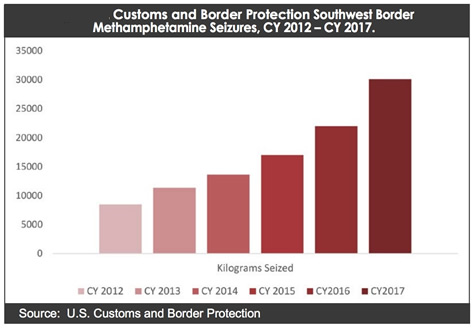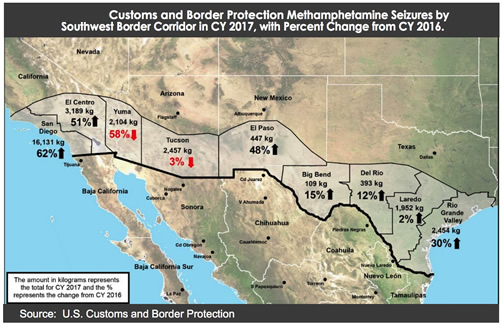 Methamphetamine laboratory seizures continue to decrease across the United States and are at the lowest level in 15 years. The passage of the Combat Methamphetamine Epidemic Act (CMEA) in 2006 reduced domestic methamphetamine production.
Methamphetamine laboratory seizures continue to decrease across the United States and are at the lowest level in 15 years. The passage of the Combat Methamphetamine Epidemic Act (CMEA) in 2006 reduced domestic methamphetamine production.Sources of Meth
 Methamphetamine laboratory seizures continue to decrease across the United States and are at the lowest level in 15 years. The passage of the Combat Methamphetamine Epidemic Act (CMEA) in 2006 reduced domestic methamphetamine production.
Methamphetamine laboratory seizures continue to decrease across the United States and are at the lowest level in 15 years. The passage of the Combat Methamphetamine Epidemic Act (CMEA) in 2006 reduced domestic methamphetamine production.
Unfortunately, the methamphetamine produced in Mexico is a high purity, high potency, low cost alternative. Shortly after the passage of the CMEA, Mexico introduced similar legislation regarding precursors, notably pseudoephedrine. Most of the methamphetamine available in the United States is now produced in Mexico and smuggled across the southwest border (SWB). Though restrictions have been placed on precursor chemicals in Mexico, Mexican transnational criminal organizations (TCOs) continue to adapt by finding alternative methods of manufacture, with much of the precursor chemicals being sourced back to companies in China.
 Mexican
Sources
Mexican
SourcesThe Drug Enforcement Administration -2018 National Drug Threat Assessment reports that the SWB remains the main entry point for the majority of methamphetamine entering the United States. According to Customs and Border Patrol 97 percent of methamphetamine seizures occur at or near the SWB and methamphetamine seizures continue to increase along the SWB. Methamphetamine seizures along the SWB increased 255 percent from CY 2012 (8,460 kilograms) to CY 2017 (30,081 kilograms) (see Figure 80). The majority (54%) of methamphetamine seized along the SWB in CY 2017 occurred in the San Diego corridor. Seizures increased in every corridor along the SWB except for El Paso and Tucson
Domestic Clandestine Labs
Many of the domestic methamphetamine laboratories seized in 2017 were small capacity production laboratories, known as the “one-pot” or “shake and bake.” A laboratory of this size generally produces two ounces or less of methamphetamine per production cycle, making it small scale and easy to conceal. Common household items (i.e. pseudoephedrine/ ephedrine tablets, lithium batteries, camp fuel, starting fluid, and cold packs) are used as ingredients and mixed inside a container, such as a plastic soda bottle. This method produces small amounts of methamphetamine, and is very portable. “One pot” laboratories are often dangerous, and in many cases can cause fires, serious injuries, or even death.
The number of domestic methamphetamine laboratories seized decreased nearly 78 percent from 2012 (13,657) to 2017 (3,036). In 2017, 81 percent of all methamphetamine laboratories seized in the United States were small laboratories capable of producing two ounces or less of methamphetamine.
Individual acquisitions
Methamphetamine is not usually sold and bought on the streets like many of the other known illicit drugs. Meth users report that they obtain their supplies of methamphetamine from friends and acquaintances. It is typically a more closed or hidden sale, prearranged by "networking" with those producing the drug. Often it is sold "by invitation only" at gatherings or "raves".
Reference
US Department of Justice, Drug enforcement Administration, 2018 National Drug Threat Assessment
Dea DCT DIR 032.18 October 2018
©RnCeus.com